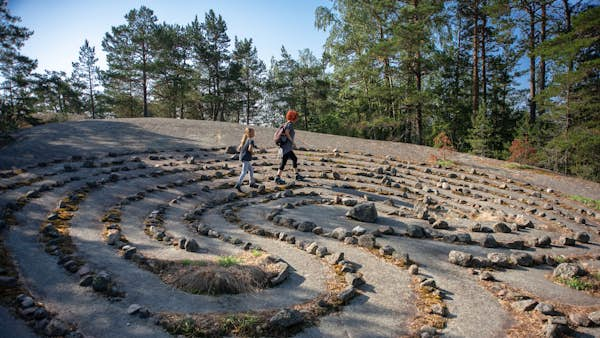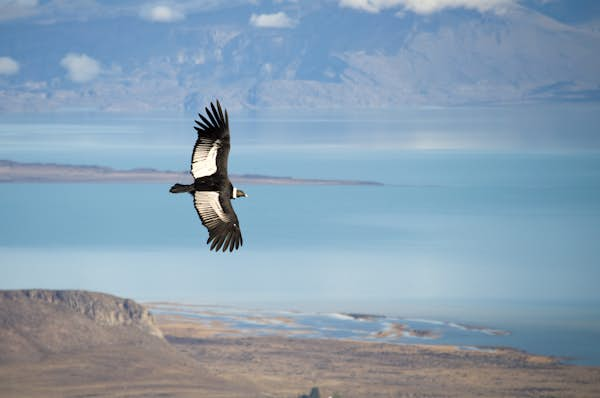


Hiked the Camino? Here are 7 pilgrimages to consider for your next challenge
A sacred path to spiritual renewal. A journey from head to heart. A test of endurance. A life-changing road to enlightenment.
Since time immemorial, people have gone on pilgrimages to seek forgiveness, give thanks, pray or find inner peace and purpose in times of change and crisis. St Augustine nailed it 1500 years ago when he said: “solvitur ambulando” (“it is solved by walking”). After all, what could be more intuitive than putting one foot in front of another, following a clear path to a goal? A pilgrimage is a metaphor for life.
And across the world, pilgrimages are booming.
In 2023, a record-breaking 446,073 pilgrims walked the Camino de Santiago to the shrine of the Apostle St James. But this well-trodden path is merely the first among equals among the world’s great pilgrimage routes.
Religious or not, you will be profoundly touched by the natural beauty, history and unique insights into culture and spirituality on these seven epic pilgrimages – slow-travel adventures taking you from the mist-draped mountains of Japan to the island-speckled south coast of Finland.
1. St Olav Waterway, Sweden and Finland
Best for island hopping and sea views
To slip away from civilization and back to nature, the island-hopping, coast-hugging St Olav Waterway that links Turku in Finland with Eckerö (Åland) in Sweden is the dream. A rousing 10-day romp of 215km (134 miles), this is a pilgrimage trail like few others. For starters, you don’t have to walk it – you can cycle or kayak if you prefer, with ferries joining the gaps.
Whatever your mode of transport, look forward to stupendous views of sea and sky. The trail skips over many rocky isles and skerries as it crosses the Åland Islands, where you have the space to zone out for a spell and be at one with the blues of the Baltic and greens of the pine forest in a place silent enough to hear your own heartbeat. Bring binoculars and you might well spot migratory birds, hares, deer and the odd elk swimming from island to island.
Following the route pilgrims hiked and sailed in the Middle Ages and honoring one of the most famous Scandi saints, this route is less about showstopping highlights and more about embracing every element and sense along the way. Admire the brilliant stars as you wild camp. Take bracingly cold post-sauna dips in the sea. Stop off in tiny, timber-built villages and savor local produce for picnics at wayside farm shops.
After a week or so, you’ll discover lost rhythms and find a deeper connection with the Nordics and their wondrous nature.

2. Kumano Kodō, Japan
Best for holy shrines and hot springs
Threading into densely wooded mountains on Japan’s Kii Peninsula, the Kumano Kodō is a UNESCO-listed network of pilgrimage trails leading to the Kumano Sanzan, or Three Grand Shrines of Kumano. Once a sacred pilgrimage trail for enlightenment-seeking emperors and samurai, these paths have been trodden for more than a millennium.
Today, the landscape they cut through continues to pulse with a special energy. Walkers can expect ethereally lit bamboo groves, fern-flecked forests and terraced rice paddies, waterfalls plunging over cliff faces and holy mountains revered as kami (gods), Buddhist temples and Shintō shrines.
The main path to Kumano is the Nakahechi Route (Imperial Route) – a well-mapped, 68km (42-mile) journey on foot to unite mind, body and spirit through the challenge of the trail and the beauty of nature. It’s a solid four days of walking up into ragged mountains, through mist-veiled forests and along old stone paths polished smooth by pilgrims’ weary-yet-determined feet. Tea houses and simple inns provide rest and refreshment in isolated villages; you’ll want to follow centuries-old ablutions rituals by bathing in the World Heritage hot springs of Yunomine Onsen. At the end, you’ll descend to the ancient shrine of Hongu Taisha, which has the world’s biggest torii gate.
Summers on the Kii can be hot and humid and winters cold, so come in the shoulder seasons for mild days and few crowds – plus spring cherry blossoms or glorious autumn foliage.

3. Via Francigena, Italy
Best for heights and hill towns
In the saintly hall of fame, few shine brighter than St Francis of Assisi, born in his namesake town in Umbria in 1181. Founder of the Franciscan order, this most venerated of Italian saints lived a life of utmost poverty and penance – we’re talking rolling around in thorn bushes to resist temptation, wearing a ragged habit (he only owned one), eating barely nothing and sleeping on stone. St Francis loved nature, saved animals and worked many a medieval miracle, from walking on water to healing the sick and raising the dead. As saints go, few can touch him.
Celebrating its 30th anniversary in 2024, the Via Francigena follows in his devout footsteps. If you thought the Camino was challenging, try this 1200km (745-mile) pilgrimage from Canterbury’s Gothic, UNESCO-listed cathedral (where Thomas Becket was killed in 1170) to Santa Maria di Leuca in Puglia at Italy’s sun-scorched heel. As you tramp from England to France, Switzerland and Italy, the weather gradually warms and skies get bluer. The landscapes that unfold are cinematically beautiful: vineyards, fast-flowing rivers and forests, olive-cloaked hills and snow-frosted Alps. In between, abbeys, castles, medieval towns and all the wonders of Rome await. On the lonely stretches, a sense of spirituality endures.

4. The Portuguese Way, Portugal
Best for an alternative route to Santiago
If the idea of Santiago appeals – yet throngs of pilgrims on the busy Camino Francés (French Way) don’t, there are other ways you can set out and earn your official Compostela certificate. While 219,785 blister-footed pilgrims trekked across the Pyrenees through France and Northern Spain to Santiago’s resplendent medieval cathedral in 2023, just 88,717 came via Portugal. Cue the popular-but-still-less-crowded Caminho Português (Portuguese Way), a spiritually uplifting, month-long, 620km (385-mile) stomp from the Portuguese capital of Lisbon to Santiago de Compostela.
Wild Atlantic coastlines, forested hills and national parks stitch together time-lost villages and some of Portugal’s most outstanding cultural sites – from alley-packed, moodily atmospheric Coimbra, medieval capital for more than a century and home to the UNESCO-listed university that’s the country’s oldest; to convent-topped Tomar, a Knights Templar stronghold; and Moorish Santarém. Stop at beaches for boat-fresh shellfish and vibrant sunsets.
The trail is well-signposted and moderately challenging (expect inclines but no real climbs); the weather tends to be agreeable, too, with spring and autumn the ideal times to walk. Tip: if you want to shave off a bit of time, just hike the 265km (165 miles) from Porto. From here, it takes “only” 10 to 12 days to reach Santiago.
5. St Paul Trail, Türkiye
Best for history and slow travel
The apostle St Paul hailed from Tarsus and spread the Christian faith in Asia Minor in the first century. Honoring this foundational early saint and tracing his footsteps as he embarked on his first missionary journey to Anatolia, the St Paul Trail presents a deep dive into a rural side of Türkiye that few visitors get to see. You’ll need to be fit for the 500km (310-mile), at-times-tough hike from the ancient city of Perge (just north of Antalya on the Mediterranean coast) to Yalvaç near Lake Eğirdir. The path is well marked, with handy white-and-red stripes on rocks and trees.
History lovers will be in their element here, as the route picks its way along stone-paved Roman roads, medieval paths and old shepherd trails, taking in aqueducts and ancient theaters; Roman, Byzantine and Ottoman towns and cities; and ruined temples, castles, mosques and churches. But the wild beauty of the Taurus Mountains also touches deep: pine, beech and juniper forests, high pastures, canyons and valleys, glass-clear streams and turquoise falls. In between are hamlets where the pace of life is refreshingly slow, where cheese and yogurt are still made the traditional way, and in which you can momentarily forget which century we live in.
Avoid the blistering heat of summer and opt instead for spring or autumn. April, May, September and October are fine times to hike this month-long trail, along which you’ll be staying in private homes, at simple B&Bs or under canvas.

6. Adam’s Peak, Sri Lanka
Best sacred mountain sunrise
Soaring high above the lush green tea plantations and forests of Sri Lanka’s cloud-wreathed Central Highlands, cone-shaped, 2243m(7360ft)-high Adam’s Peak (Śrī Pāda) is the country’s most sacred mountain. Scrambling up 5200 steps to the top is a rite of passage for pilgrims of different faiths, who flock here from the world over to pray and express gratitude.
The name refers to the giant footprint-shaped marking at the summit, which some say is where Adam first set foot on earth when he was cast out of the Garden of Eden. Buddhists believe it was left by Buddha en route to paradise, while Hindus insist it is Shiva’s doing. No matter the religion, this holiest of peaks is the end goal of a long, sweaty, back-breaking climb from the village of Dalhousie (allow around 8 hours for the up-and-back trek).
Religious or not, climbing Adam’s Peak is a spiritual experience – and proof that you don’t need to hike for days or weeks to experience the transformative power of pilgrimage. Begin at night as the stars twinkle, joining fellow pilgrims with head-torches flickering like fireflies to climb the steps. You’ll then arrive at the summit as day breaks and sunrise touches the island like a golden blessing. The pilgrimage season begins on poya (full moon) day in December and runs until the Vesak festival in May.

7. Wexford Pembrokeshire Pilgrim Way, Ireland and Wales
Best for wild waves and Celtic spirit
Just imagine for a second how St Aidan must have felt back in the sixth century as he trod, staff in hand, along the wave-whipped shores of the Atlantic from Ferns in Ireland to St Davids in Wales to meet his mentor St David.
Now drop yourself right in the moment.
The recently launched Wexford-Pembrokeshire Pilgrim Way is a tale of two saints and two Celtic lands. Heading up and over gorse-clad cliff and along dune-flanked beach for 260km (162 miles) and crossing the Irish Sea by ferry, this pilgrimage trail enthralls with cultural heritage in the form of ruined abbeys, romantic castles, Celtic wells, Marian shrines and the clincher: magnificent St David’s Cathedral, which hosts the relics of Wales’ beloved patron saint.
Believer or not, nature is sure to grab you. In what the Celts would have described as a “liminal space” – where the gap between heaven and earth is small – these coastal landscapes touch the soul. Feel the spiritual connection with the living world standing atop wild, storm-smashed, lighthouse-topped Strumble Head, where seabirds (fulmars, razorbills, guillemots, peregrines) dive and screech while dolphins and seals splash offshore.
Broken up into nine bite-sized day walks of roughly 14 miles (22km) apiece and digitally way-marked, the trail is easy enough to hike and navigate, with overnight accommodation offered at sanctuaries, farms and hostels.

9 creatures to look out for when traveling in Patagonia
Some of the largest and most unspoiled tracts of wilderness on Earth, Patagonia’s temperate rainforests, towering mountain ranges, grasslands, fjords, lakes and rivers are home to more than 500 wildlife species, making it one of the most diverse and fauna-rich regions in South America.
Birdwatchers, wildlife photographers and wildlife lovers alike come to this vast natural playground in the hopes of spotting condors, penguins, guanacos, pumas, whales and other creatures, but Patagonia’s harsh continental climate, challenging topography and the encroachment of estancias (ranches) on some habitats mean that some of the more elusive beasts may only be spotted in specific areas at specific times of the year.
Here’s our guide to Patagonia’s most iconic animals and birds and where best to find them.
Condors are commonly spotted in Patagonia
The national bird of Bolivia, Chile, Colombia and Ecuador, the Andean condor is one of the largest birds on Earth, with a massive 3m (10ft) wingspan that puts it ahead of its Californian cousins in terms of sheer size. Contrary to popular belief that once saw them hunted by sheep ranch owners, condors are scavengers – giant vultures – rather than birds of prey, and thus not capable of carrying off livestock. Instead, they act as a clean-up crew, picking over the carcasses of dead animals.
Where to see them: Bald-headed, black, with distinctive white feathery patches on their wings, condors are most commonly spotted in the Andes, in Torres del Paine, Perito Moreno, Los Glaciares, Patagonia and Cerro Castillo national parks, where they take advantage of the strong air currents to keep themselves aloft. They live near the coast as well, where there are strong ocean breezes and are frequently spotted circling above Parque Nacional Monte de León.

Sightings of pumas are rare
Kenya and Tanzania have lions, India and Siberia have tigers, the Amazon Basin is home to the jaguar, and Patagonia has the puma. Once hunted almost to extinction, the Patagonian mountain lion has made a miraculous recovery over the past few decades, due to the protective measures in place and the numerous national parks teeming with food. The largest land carnivore in the region, the tan-colored puma is a powerful predator that can bring down prey much bigger than itself.
Where to see them: Puma spotting tops the list for most wildlife lovers, but since the big cats are nocturnal and shy, sightings are few and far between. The best place to see them is Parque Nacional Torres del Paine, where there’s a large and thriving population, thanks mainly to an abundance of guanacos and wild horses. In fact, this writer spotted a very large puma while hiking there solo – an exhilarating yet terrifying experience, despite the fact that there have been no puma attacks on humans in Patagonia in decades. The big cats have also been seen at Parque Nacional Patagonia and Parque Nacional Los Glaciares.

Guanacos can be seen year-round
A close relative of the domesticated llama and alpaca and South America’s largest camelid (though without a hump!), the guanaco can be seen in large numbers in Patagonia year-round. A pale tawny color, with long, graceful necks and legs, huge eyelashes and soft lips adept at finding nourishment among Patagonia’s thorny scrubland, guanacos are social, alert and inquisitive animals that tend to live in small herds, composed of up to ten females, a dominant male and their offspring. In winter, they band together in much larger groups.
The herds currently roaming Patagonia’s steppe and forest represent a mere fraction of the guanacos that once inhabited these grasslands. Their numbers were severely depleted after the arrival of Europeans, and while it’s no longer legal to hunt them, they still have to compete with sheep for food.
Where to see them: Guanacos are particularly numerous in Tierra del Fuego, where there are no pumas, but sightings are also frequent in Parque Nacional Monte de León – and pretty much guaranteed in Parque Nacional Torres del Paine, where they number at least 2000, and Parque Nacional Patagonia, known as the Serengeti of the Southern Cone. They share a habitat with the Patagonian armadillo, which like to burrow near lakes, and the swift-footed ñandú (rhea).

Look out for whales and dolphins
Four whale species can be seen in Patagonia’s coastal waters: humpback whales, orcas, southern right whales and – very rarely – blue whales. From December to March, Whalesound and Solo Expediciones run dedicated whale-watching tours from Punta Arenas to Francisco Coloane Marine Park in the southern Chilean fjords, where humpback whales, en route between Antarctica and the Arctic, stop to feed and perform their spectacular breaching displays.
Where to see them: Orcas can be spotted around Argentina’s Peninsula Valdés, hunting seals and sea lions, but you’re much more likely to catch sight of endangered southern right whales – between April and December, more than 2000 of them come to the sheltered bays around the peninsula to breed and raise their young. Regular boat trips depart from the village of Puerto Pirámides.
During these boat trips, you’re also likely to see dusky dolphins – small, playful dolphins that like swimming in the wake of boats and engaging in acrobatic displays, leaping high above the water. The black-and-white Commerson’s dolphin is very frequently seen during routine ferry crossings of the Magellan Strait, from mainland Patagonia to Tierra del Fuego; small pods often follow the ferry. As for the world’s largest mammal? With luck on your side, you could spot a blue whale if you happen to be on a ferry in northern Chilean Patagonia, en route to the island of Chiloé. There have been occasional sightings in the Gulf of Corcovado as well.

Vizcacha live in large burrowing colonies
Adorably cute, extremely agile and looking like a cross between a large rabbit and a chinchilla with a longer, curlier tail, vizcacha (sometimes translated as “bunny-squirrel”) are usually spotted bounding up steep slopes. Reddish-gray in color and blending in well with their mountainous habitat, these large rodents are endemic to South America and live in large burrowing colonies.
Where to see them: In southern Chile, you’re likely to spot them among the lunar landscape of Reserva Nacional Jeinimeni, while in Argentina, the plains vizcacha inhabiting the pampas are seen as pests that compete with livestock for food.

The extremely endangered huemul is tricky to find
Native to the mountains and periglacial scrubland of southern Chile and Argentina, the huemul is a notoriously shy deer that’s critically endangered – there are only 1500 or so left in the wild, the majority of them in Chile. The stocky southern deer is Chile’s national animal; it even appears on the country’s coat of arms, alongside the condor.
Where to see them: You would be incredibly lucky to spot one, though there have been occasional sightings in Parque Nacional Patagonia, Parque Nacional Torres del Paine and Reserva Natural Los Huemules. The latter is a private nature reserve in southern Argentina, near El Chaltén; its founders hope that habitat preservation and scientific study will help increase the deers’ numbers.

Spot flocks of Chilean flamingos
When we think of flamingos, we usually think of the tropics, and Patagonia seems an unlikely home for these graceful stilt-legged birds. Paler than the Caribbean flamingo but pinker than the Greater flamingo, Chilean flamingos live in large flocks.
Where to see them: Chilean flamingos are often spotted during the southern summer on the approach to Parque Nacional Torres del Paine – a flash of pink in the shallows of the pale-blue Laguna Amarga. They also inhabit the lakes and lagoons of Parque Nacional Patagonia; if you’re driving through the Chacabuco Valley in the direction of the border with Argentina, you can see them in large numbers at Laguna Seca.

Penguin chicks hatch in November and December
What’s black and white and outnumbers Patagonia’s human inhabitants almost two to one? If you’ve answered “penguin,” you’re absolutely right! From October to April, Patagonia hosts around 3.4 million Magellanic penguins as they swim back to their burrows from the coast of Brazil to nest and lay eggs. Chicks hatch in November and December, so if you visit then, you’re likely to get glimpses of these beaked balls of fluff.
Where to see them: The biggest Magellanic penguin colonies are in Punta Tombo, Argentina, reachable via driving or tour bus, and Isla Magdalena, Chile, accessed via half-day boat tours operated by Turismo Comapa, from Punta Arenas. The Magellanic penguin is by far the most common penguin you’re likely to spot along Patagonia’s coastline.
That said, further south, Isla Martillo – in the Beagle Channel near Ushuaia, reachable via boat tour with Tangol Tours – is also home to Gentoo penguins, while rockhopper penguins can be seen along the coast east of Argentina’s Puerto Deseado. There’s also a small king penguin colony on the main island of Tierra del Fuego, near Bahía Inútil, that’s grown in size over the past few years, and it’s the only place outside the Falklands, South Georgia and Antarctica where you can actually see these magnificent birds. Chile Nativo runs full-day tours from Punta Arenas.
Beavers were introduced to the region in 1946
In 1946, the Argentinian military came up with the bright idea of importing ten pairs of Canadian beavers from Manitoba and letting them loose in Tierra del Fuego, in the hopes of kicking off a lucrative fur trade and attracting more settlers to the sparsely populated southernmost region. With no natural predators to hold them back, the beaver population spread like wildfire, with numbers estimated between 70,000 and 100,000 today, and caused as much damage to Fuegian forests as wildfires.
Where to see them: If you’re looking to spot these industrious water-loving rodents, you’re likely to come across their dams and large stretches of ghost forest where thriving lenga (southern beech) used to grow – particularly if you go trekking on Chile’s Isla Navarino or take to the hiking trails in Parque Nacional Tierra del Fuego near Ushuaia.
Make it happen
Wildlife spotting in Patagonia is really easy, and unless you’ve got pumas or huemuls on your bucket list, you don’t even need a dedicated guide to make it happen. You’re likely to see ñandú (rhea) while driving Patagonia’s traffic-light roads; guanacos and endemic birds, such as the Magellanic woodpecker and rufous-tailed hawks, while hiking the trails of national parks and nature reserves; and a wealth of sea birds, seals and sea lions just by visiting Chile’s and Argentina’s coastlines.
However, if you’re coming to Patagonia specifically to see the region’s rarer and harder-to-spot creatures, it’s worth looking into multiday wildlife safaris offered by operators such as Chile Nativo, Swoop Patagonia, EcoCamp Patagonia, Eagle-Eye Tours, and Far South Expeditions, to name a handful of reputable outfitters.

The Best Winter Nails to Inspire Your Manicures This Season
Beauty
11 Unique and Instagrammable Ways to Step Up Your French Manicure Game
The classic French tip was long due for an upgrade. Here are all the updated French manicures to try in 2020, from tie-dye tips to bold animal prints.
08.26.2020 by Paige Levenson





